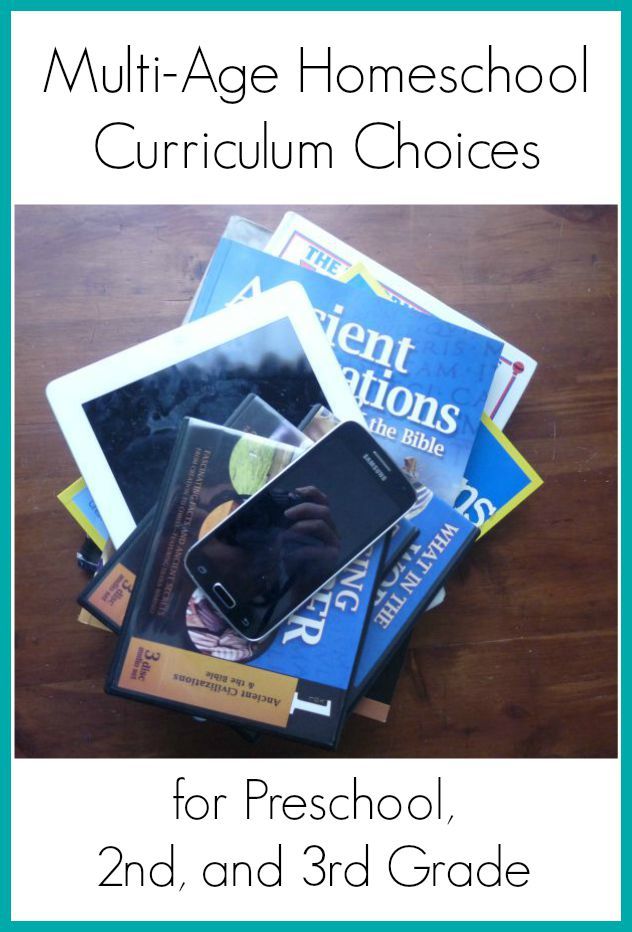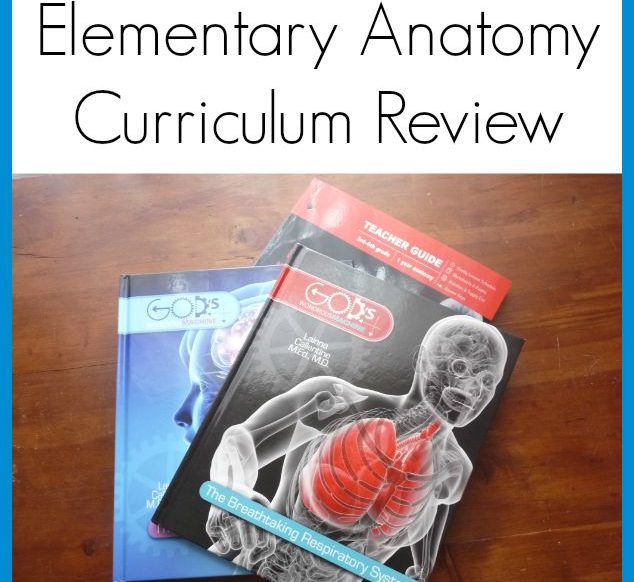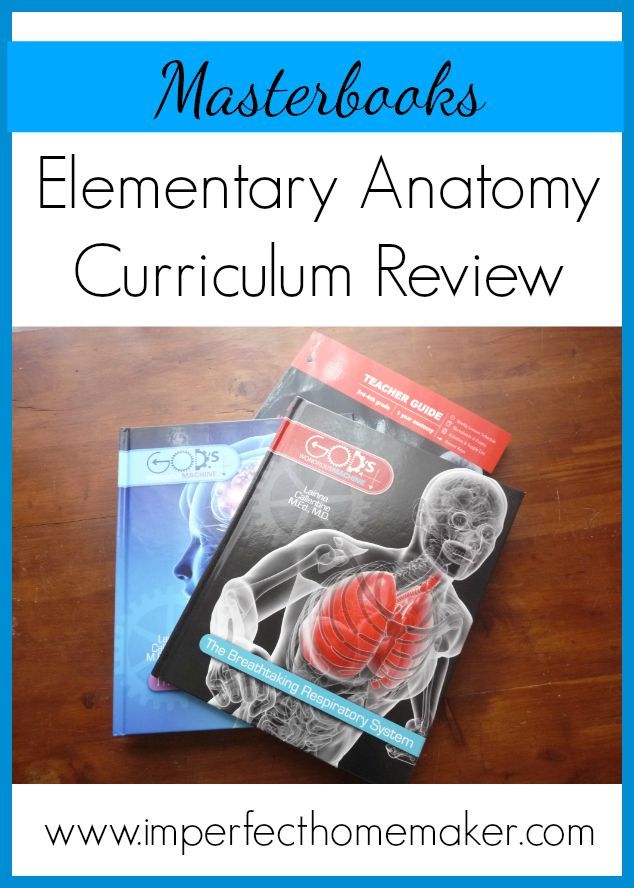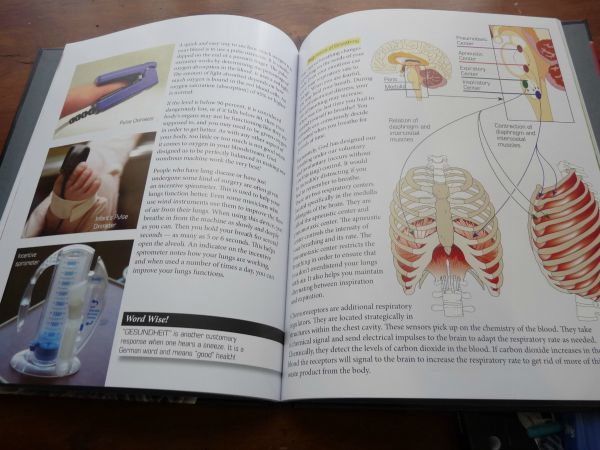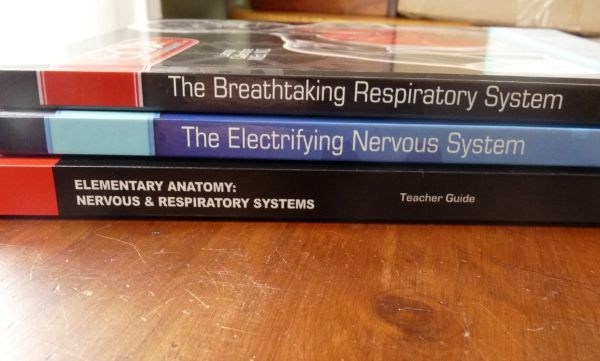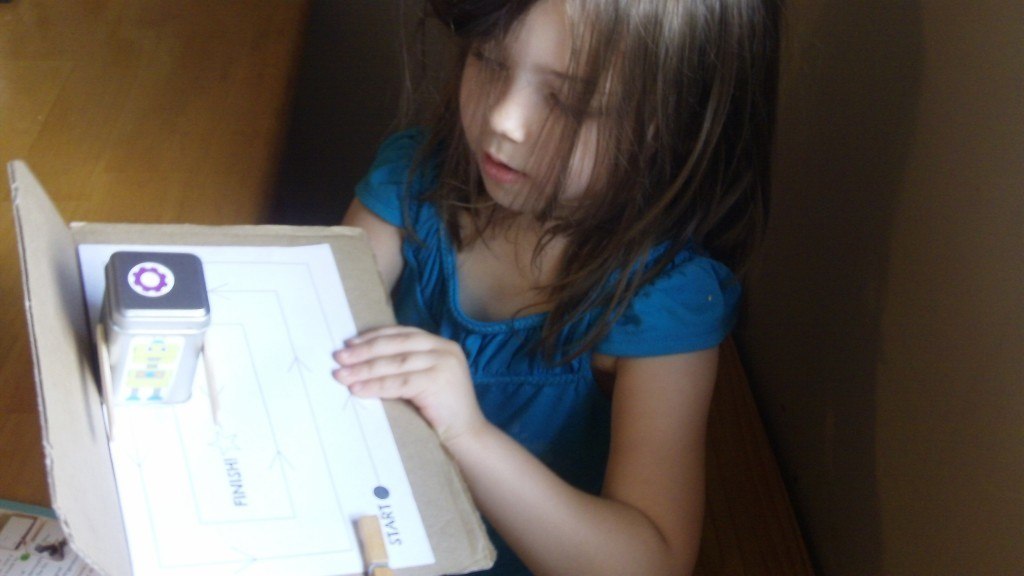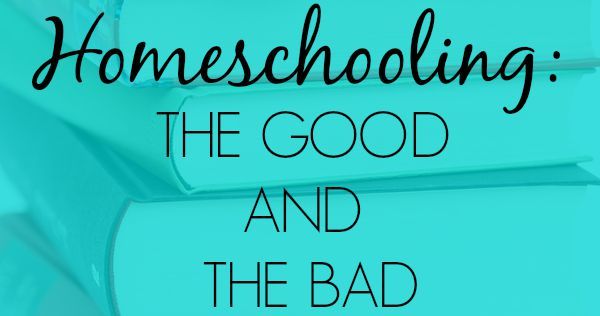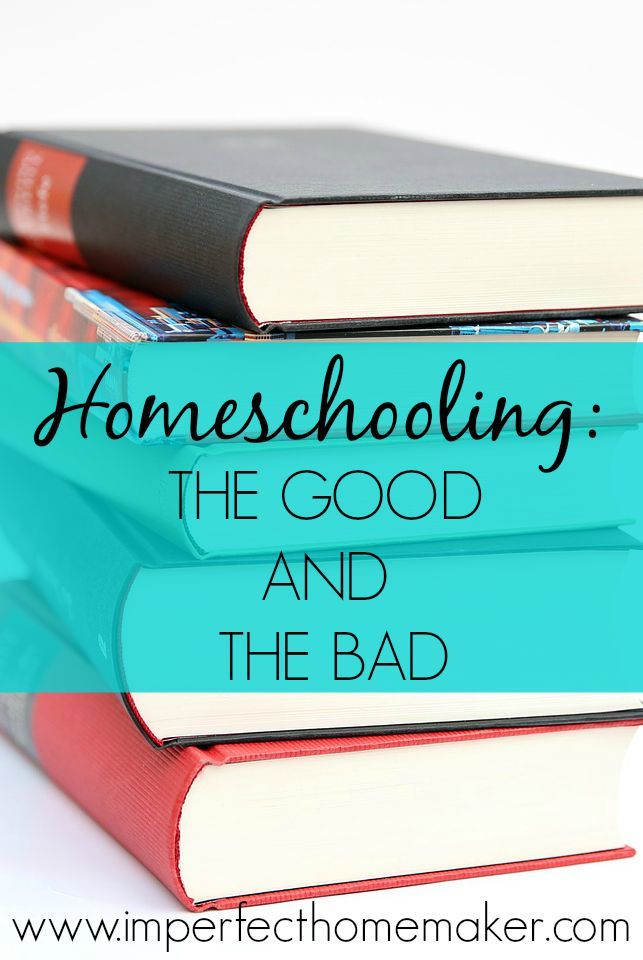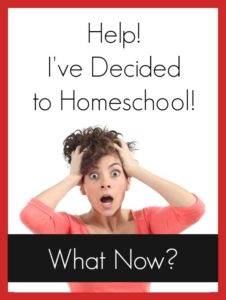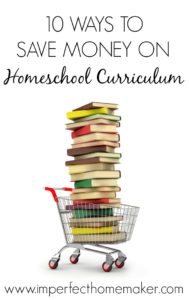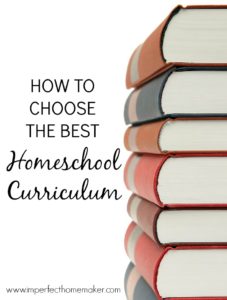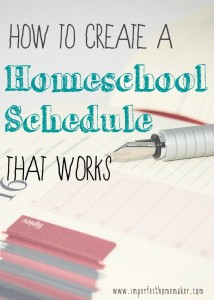Join Me for a 21 Day Fitness Challenge!
Uh oh! You have reached a page that no longer exists.
Are you a Christian homemaker? I would love to connect with you via email!
Multi-Age Homeschool Curriculum Choices for Preschool, 2nd, and 3rd Grade
Today I'm sharing our curriculum choices. Hopefully it will be helpful to some of you who have children the same age as mine!
I wanted to be able to combine the kids' schooling as much as I could. I enjoy the “one room schoolhouse” style, but I do find it works better with certain curriculum than others.
I picked most of these in the spring, and we started using them in the summer so that I could make sure before the school year if it would work.
Here's what we chose:
Bible
Last year we used a video curriculum for all of our subjects, but the kids' favorite was by far their Bible class. I enjoyed having their Bible class on video as well because it gave me an opportunity to straighten the house, put in a load of laundry, get the baby dressed, etc. I didn't have to be around because I knew the kids were enjoying their class enough that they stayed tuned in and didn't get into any mischief!
This year we will be using BJU Bible Truths Online Learning. I loved the fact that they offer their Bible class as a stand-alone option since that was all I wanted to use as far as video courses. I know that their materials will be in line with what we believe Biblically, and the classes look like they'll be really interactive and enjoyable!
All kids will do Bible simultaneously.
Math
For math, we are using Khan Academy for my 3rd grader and miscellaneous worksheets for my 1st/2nd grader.
We've already been using Khan Academy, and it's been working very well for us! My son is motivated to do his math because he can see the points he is racking up every time he answers a question correctly. It also helps him focus because he only sees one question at a time and he doesn't get overwhelmed with looking at a whole paper that he has to complete. Most days he asks if he can keep going on math because he doesn't want to stop yet! That is a MAJOR change from last year! (Oh, and did I mention Khan Academy is FREE?!)
We also have the app on our iPad so they can use it on there if someone else is using the computer.
I am having my daughter work through 2nd grade worksheets that she didn't finish last year (I bought her a set last year when her brother was in 2nd grade because she liked to listen in to his classes. She couldn't quite keep up with all the paperwork, though, so we are going through and finishing those and reviewing all of that.)
I am also having both of them do XtraMath every day for drilling their math facts. I am very happy with this program too. It's saving me lots of time drilling them myself, and it's actually doing a better job! The program is intuitive – it can tell which facts need the most work, and it will make those problems show up more often until the student starts answering them quickly enough on a consistent basis. The kids enjoy this program too, and it's good motivation for them to try their best.
The 2 older children work on math simultaneously – each on separate devices – while I work with my preschooler. (I do not use a formal curriculum for preschool.)
Language/Spelling/Writing
For language, I am working with both kids together. We are using Primary Language Lessons. I have it downloaded on my phone in Google Play, so it always opens up to the last page I was on.
I really wanted to cut down on the amount of paperwork the kids had to do this year because it was really discouraging them (and me too!) I started digging around to find something that would combine language, spelling, and writing so that it was all being practiced simultaneously, cutting down on time and busywork.
When I found Primary Language Lessons, I knew it would be perfect. We have been using that through the summer just to make sure it would work for us, and it is working beautifully. (And you can't beat free!)
Basically I just open it up and teach the lesson (only takes about 5 minutes), then they have to write sentences about the lesson. Sometimes they are making up the sentences themselves, while practicing proper grammar and punctuation; sometimes they are filling in blanks with things like they're, their, there or is, are.
They have to use their neatest penmanship, and I make them practice any particular letters with which they are struggling.
I also check for misspelled words and add those to a list, which becomes their spelling list for the week. They then copy their spelling list daily, and we practice spelling the words aloud together also.
I love how the process is so streamlined. The kids are not feeling overwhelmed, which means they actually work faster.
I'm not sure if I would feel comfortable doing language this way if they did not have a very strong foundation from Kindergarten through 2nd grade, though. We used A Beka curriculum for those grades, which has a very strong emphasis on phonics, and we have drilled and drilled the special sounds for 3 years. When we are practicing spelling, we are reviewing the special sounds and why those words are spelled that way.
The two older children do language/spelling/writing simultaneously. I work on letters and sounds with my preschooler at a separate time.
Reading
I had a “duh” moment.
My kids read every spare moment! On their bed, in a tree, walking down the road (had to put a stop to that one!)…
Why should I make them sit down and read and prolong their school day?! I just let them read whatever and whenever they want, and we don't use a reading curriculum.
I do like for them to read out loud to me while I'm cooking supper. That way I can ask them comprehension and vocabulary questions just to be sure they're getting all they can out of their reading.
If my kids weren't good readers, I may have to consider a formal reading curriculum, but at the same time, I'm not so sure if that would be the case. I sort of feel like taking this approach all along is part of what has made them love reading — it's always been something they get to do, for fun!
Reading happens organically throughout the day. There is not a set time for this.
History
I really wanted to use a history curriculum that lines up Biblical history with world history so the kids (and myself!) could see where world events fit into the Bible as well get more insight into the cultures of Biblical times. I ended up going with Diana Waring's Ancient Civilizations and the Bible. It is really geared a little more for older students, but the beauty of this curriculum is that it is purposely designed for the student to explore his interests and to learn using the style that suits him best.
I've set aside 15 minutes of our school day simply to decide what we're going to do for history. The book offers lots of suggestions for learning resources for the current topic (crafts, books, videos, etc.) so the kids and I decide together what will fun and feasible.
Once we've decided what we explore and what we'll do, we simply incorporate that into our day instead of making it a part of school. There is some book learning to do as well as supplementary books that I read aloud, but there is also time to do lots of hands-on activities like making an Egyptian costume, cooking an ancient Egyptian recipe, or building pyramids in the sand!
There are also supplementary CDs that we listen to while I'm cooking supper. The kids play with blocks at the table to keep their hands occupied while they listen.
All children do history together.
Science
We are using schoolhouse teachers for science.
All 3 children do science simultaneously.
Art
We will be using Baby Lamb's Book of Art. It's for ages 3-5, but I don't think the older ones will care, and I needed something that they can all do together, including the 4 year old.
All children do art simultaneously.
Greek
Yes. Yes I do plan to teach my children Biblical Greek. I want them to know how to study God's Word in depth, and I think it will be better to get them started while their minds are young and sharp. We'll be using Hey Andrew, Teach Me Some Greek! Level 1.
All children do Greek simultaneously, although the youngest will just be listening in and picking up whatever he can at this point.
Typing
I would like to get the kids typing a couple times a week. Does anyone know of a good program? This is the one thing I haven' figured out yet!
Free Dr. Bronner’s Castile Soap for my Readers
I've been using ePantry for 5 or 6 months now, and I am LOVING it!
Every month I get all natural household products delivered to my door — usually after I've forgotten that I even needed to replenish my supply!
(My forgetful…er…busy self thanks me that I have my orders on autopilot so that I get the things I need before I even think about needing them.)
Even though the subscription service has saved my hide many times when I was out of stuff and it just magically showed up at my door, I also like the fact that I am not tied to it. If money is tight or if I realize I haven't used as much laundry soap as normal, I can simply change the next month's shipment or cancel it altogether.
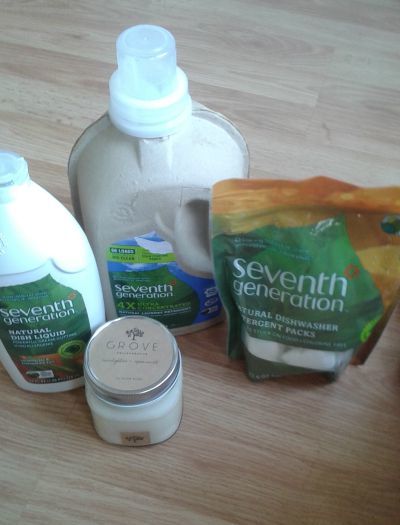 One of my recent orders from ePantry
One of my recent orders from ePantry
ePantry carries a great selection of natural cleaning and personal care products and they've recently started carrying Dr. Bronner's liquid castile soap, which is one of the things I use most around the house.
They've graciously offered a free 32 oz. bottle of Dr. Bronner's liquid castile soap to any of my readers who want to try out their service!
Here's how it works:
1. Sign up here.
2. Answer a couple questions about the products you use.
3. ePantry will set up a sample delivery schedule for you, which you can customize to your liking.
4. Your free bottle of Dr. Bronner's soap will be added to your first order. (You'll need to have a final total of $20 or more for the offer to be added.)
5. This offer is only valid through August 17th, so snatch it up if you're interested!
Need ideas for how to use your free Dr. Bronner's soap?
Here is a list of tons of ways to use it all around the house!
 My preparations for a YouTube video on how to make your own non-toxic disinfectant – I used my Dr. Bronner's soap of course! Watch for the video soon!
My preparations for a YouTube video on how to make your own non-toxic disinfectant – I used my Dr. Bronner's soap of course! Watch for the video soon!
A couple last things to note:
Refer friends and family, get $10 off!
- If you refer friends and family to ePantry, each person you refer will get $10 in credit for their first order! And, more good news! You will also receive $10 in credit for each person who checks out. It’s a win-win!
To top it all off, ePantry has wonderful customer service! They even offer an extra $2 off if you answer the question in the chat box. So go on ahead and check it out!
Elementary Anatomy Homeschool Curriculum Review
I was sponsored by Masterbooks to review their Elementary Anatomy homeschool curriculum and am excited to share my experience! As always, all opinions are 100% my own, and I am honored to partner with a company that I believe in.
Although this curriculum is for 3rd through 6th grade, I am actually using it with my 2nd and 3rd graders. You know a curriculum is good when it is easy enough for younger children to understand without being to easy or babyish for older students.
What I liked:
- Gorgeous, full-color photos and diagrams
- Written with a Biblical worldview
- Ready-made lesson plans
- Lots of hands-on activities; most do not require special supplies other than household items
- All-inclusive curriculum; all worksheets, tests, flashcards, etc. are included in the teacher book
- Homeschooling families are free to copy consumable pages for use with multiple children
What I didn't quite love:
I am not very “mainstream” in my views when it comes to health and wellness. The curriculum is written by an M.D. and the “mainstream” philosophies of the author have shown up a few times throughout the textbook. That's not enough to make me dislike the curriculum by any means; just something to be aware of if you're a little more on the “alternative” side. 🙂
Overall conclusion: (aka “Would I choose this curriculum again?”)
Yes! Without a doubt, yes! Not only are these books gorgeous (which makes them very appealing to kids), the lessons are thorough without being too long; I like the ratio of bookwork to hands-on activity, the price is very reasonable, and (most importantly to me) it's a completely open-and-go curriculum – no planning for mom! (Yay!)
You can purchase this curriculum on the Masterbooks website – and be sure to browse through all their other homeschooling products while you're there! Curriculum sets are 26% off through August 31st and there is FREE SHIPPING on any order over $75!
Green Kid Crafts (Giveaway)
Green Kid Crafts is a subscription program that delivers creative and eco-friendly STEM (science, technology, engineering, mathematics) activities to the doorsteps of children all around the country each month.
Your child could be one of the children enjoying the fun and educational activities from a Green Kid Crafts box!
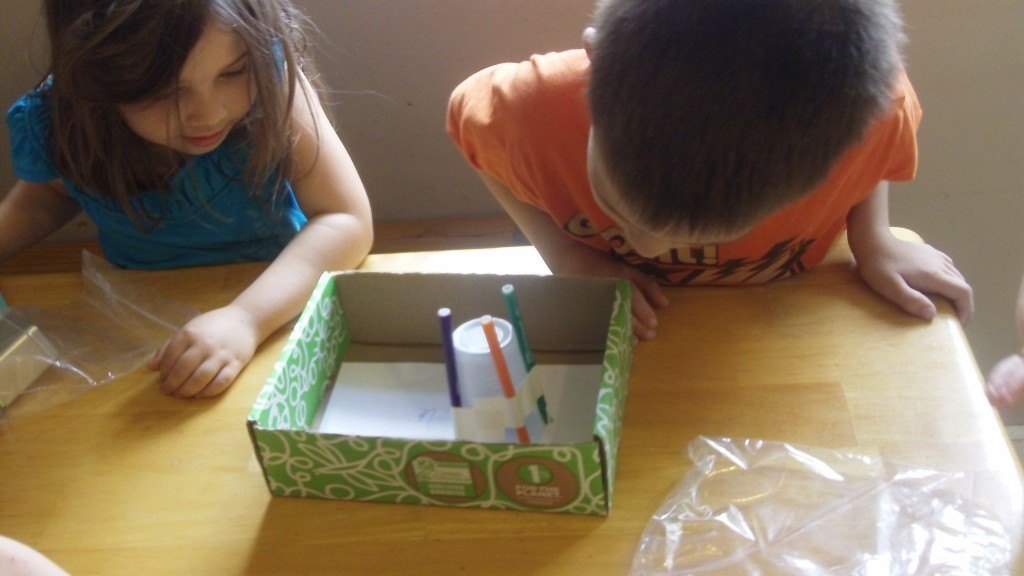 My children enjoying their box this month
My children enjoying their box this month
Each month’s box is packed with 4 to 8 unique and engaging activity kits that are developed by teachers, crafty moms, and STEM experts to support key developmental skills for kids ages 3-10.
Each activity is also kid tested and parent approved for fun.
There is a new theme each month: past themes have included Mad Scientist, Nocturnal Animals, Around the World, Outer Space, and Feathered Friends.
You can purchase subscriptions on a month-to-month, 3, 6 or 12 month duration. Subscription boxes also make great gifts! Subscriptions start at $16.95 / month, and sibling subscriptions are also available. Order at www.greenkidcrafts.com.
COUPON: Use the code take5sp for $5.00 off anything in the Green Kid Crafts store!
ONE WINNER IS GOING TO RECEIVE A ONE MONTH SUBSCRIPTION TO GREEN KID CRAFTS!
Enter using the form below:
Homeschooling: The Good and the Bad
If you're considering homeschooling your children, you definitely want to go into it with your eyes wide open. Even if you know without a doubt that God wants you to homeschool your children (we certainly do), you should still be aware that there are both good and bad aspects to homeschooling. Just because it's the right thing for your family, don't expect it to necessarily be all sunshine and roses. Will you allow me to share the good side and then to make you aware of the bad side of homeschooling as well? When you're aware of the not-so-good things you can much more easily make preparations to overcome them.
The good:
* You make the decision about what your children learn. You have total control over what subjects your children are learning. You can protect their minds from things that are contrary to your worldview. There is no concern over academics that may be less-than-stellar or expectations that may be unreasonable for a child with learning difficulties.
* You make the decisions about how your children learn. There is no way a school classroom can tailor its teaching style for each child. Yet each child differs. As a home schooling parent, you can teach your child in the style that best fits him or her, and you can tweak your teaching style as needed.
* You get to choose the curriculum. This ties in with the “what your children learn” note listed above. You can decide how many books, worksheets, crafts, and so forth that your student does. You can reject or accept aspects of various curricula and/or design your own.
* Your child gets one-on-one instruction. Time and again, studies have shown that children learn well with individual instruction.
The bad:
* Home schooling takes time. Not only do you have to commit to the actual teaching time; depending on the curriculum, you may have to research and prepare lessons, copy or print out worksheets, maps, exercises, etc., and keep careful track of your child's progress. This all means less time to run errands, clean the house, cook meals, etc.
* Depending on the laws and regulations in your area, you will have to present a portfolio or submit your child to standardized testing. This means you have to keep careful records.
* Home schooling can cost money. Some curricula are very inexpensive or even free, but often the less expensive options take up a lot more time (searching for library books, printing your own materials, etc.) Finding something that is less labor intensive or finding the right materials for your child can cost much more, sometimes as much as $1000 a year.
* Criticism and even contempt from others unfortunately comes with the territory of home schooling. Those who tend to doubt themselves or who are overly concerned with what other people think may find this aspect of home schooling stressful.
Does the fact that there are some bad aspects to homeschooling mean that you shouldn't do it? Not at all! Sending your child to school will come with both good and bad aspects also. You just need to be prepared for the not so pleasant parts so that you can prepare yourself properly.
Homeschooling through the good and the bad will take work, but it will be rewarding!
You might want to take a look at these other posts too:

